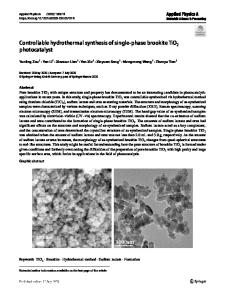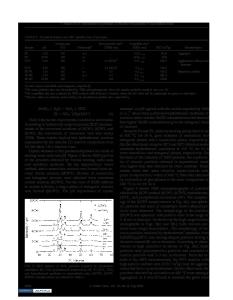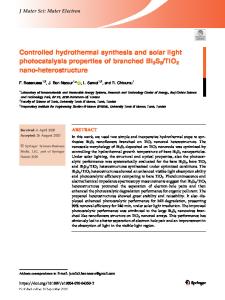Hydrothermal synthesis of well-dispersed TiO 2 nano-crystals
- PDF / 220,347 Bytes
- 4 Pages / 612 x 792 pts (letter) Page_size
- 117 Downloads / 366 Views
Well-dispersed anatase and rutile nano-particles were prepared via hydrothermal treatment of tetrabutylammonium hydroxide-peptized and HNO3-peptized sols at 240 °C. A broad particle size distribution of anatase crystals was observed in the nonpeptized TiO2 species hydrothermally treated at 240 °C. X-ray diffraction and transmission electron microscopy, as well as zeta potential measurement, were used to characterize the particles. The formation of the well-dispersed anatase and rutile particles from the peptized samples could be attributed to (i) homogeneous distribution of the component in the peptized sols, and (ii) the high long-range electrostatic forces between particles in the presence of both peptizers, which were not present in the nonpeptized samples. This work provided a new way to prepare nano-crystals of titania.
The tremendous possibilities for the application of titania in catalysts, photocatalysts, pigments, sensors, etc., have generated interest in exploring more efficient synthesis methods for preparing nano-titania crystals. Recently, wet chemical synthesis routes including sol-gel, hydrothermal, and precipitation techniques have been widely used to prepare nanocrystalline particles.1– 4 Strong agglomerates can be easily formed in the sol-gelor precipitate-derived nano-powders after further calcination to obtain a crystalline phase, which will deteriorate the properties of the final products. However, hydrothermal synthesis, in which chemical reactions can occur in aqueous or organo-aqueous media, under the simultaneous generation of heat and pressure, is more effective for achieving nanocrystalline titania phase with less agglomeration.5–9 Agglomerate formation easily takes place in the nanosized particles due to their large specific surface area. The degree of agglomeration among particles can be alleviated when dispersing agents such as polyelectrolytes are added, creating electrostatic, steric, or electrosteric stabilization.10–12 These large repulsive forces can retard collisions among the particles and reduce the possibility of forming agglomerates. In the present work, electrostatic stabilization of the particles by HNO3 or teterabutylammonium hydroxide (TBNOH), which were used to peptize the amorphous hydrous titania, was achieved. Well-dispersed anatase and rutile nanocrystals were obtained by hydrothermally treating the HNO3 and TBNOH peptized sols at 240 °C. The detailed procedures for the preparation of anatase and rutile powders through hydrothermal synthesis have been described in our previous work.8,9 Titanium butoxide [Ti(OBu)4] (Aldrich, Madrid, Spain, A. R. Grade) J. Mater. Res., Vol. 17, No. 9, Sep 2002
http://journals.cambridge.org
Downloaded: 07 Dec 2014
was used as precursor without further purification. TBNOH (Merck, Munich, Germany, A. R. Grade) and HNO3 were used as peptizers. The molar ratios of [H+]/[Ti] or [TBNOH]/[Ti] were fixed at 1 and 0.25, respectively. The peptized sols were filled in Teflon containers and treated at 240 °C for two hours using a heating rate of
Data Loading...











